JAJSA57E September 2003 – August 2016 LP3875-ADJ
PRODUCTION DATA.
- 1 特長
- 2 アプリケーション
- 3 概要
- 4 改訂履歴
- 5 Pin Configuration and Functions
- 6 Specifications
- 7 Detailed Description
-
8 Application and Implementation
- 8.1 Application Information
- 8.2
Typical Application
- 8.2.1 Design Requirements
- 8.2.2
Detailed Design Procedure
- 8.2.2.1 External Capacitors
- 8.2.2.2 CFF (Feed Forward Capacitor)
- 8.2.2.3 Selecting a Capacitor
- 8.2.2.4 Capacitor Characteristics
- 8.2.2.5 Setting The Output Voltage
- 8.2.2.6 Turnon Characteristics for Output Voltages Programmed to 2 V or Less
- 8.2.2.7 RFI/EMI Susceptibility
- 8.2.2.8 Output Noise
- 8.2.2.9 Power Dissipation
- 8.2.2.10 Estimating Junction Temperature
- 8.2.3 Application Curves
- 9 Power Supply Recommendations
- 10Layout
- 11デバイスおよびドキュメントのサポート
- 12メカニカル、パッケージ、および注文情報
パッケージ・オプション
メカニカル・データ(パッケージ|ピン)
サーマルパッド・メカニカル・データ
- KTT|5
発注情報
8 Application and Implementation
NOTE
Information in the following applications sections is not part of the TI component specification, and TI does not warrant its accuracy or completeness. TI’s customers are responsible for determining suitability of components for their purposes. Customers should validate and test their design implementation to confirm system functionality.
8.1 Application Information
The LP3875-ADJ device is an LDO linear regulator designed to provide high load current of up to 1.5 A, low dropout voltage, and low quiescent current in shutdown mode. Figure 7 shows the typical application circuit for this device.
8.1.1 Reverse Current Path
The internal MOSFET in the LP3875-ADJ an inherent parasitic diode. During normal operation, the input voltage is higher than the output voltage and the parasitic diode is reverse biased. However, if the output is pulled above the input in an application, then current flows from the output to the input as the parasitic diode gets forward biased. The output can be pulled above the input as long as the current in the parasitic diode is limited to 200-mA continuous and 1-A peak.
8.2 Typical Application
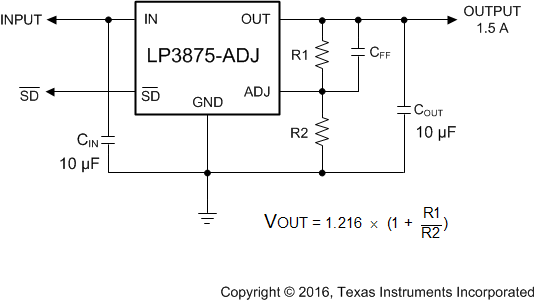 Figure 7. LP3875-ADJ Typical Application Circuit
Figure 7. LP3875-ADJ Typical Application Circuit
8.2.1 Design Requirements
For typical linear regulator LDO applications, use the parameters listed in Table 1:
Table 1. Design Parameters
| DESIGN PARAMETER | EXAMPLE VALUE |
|---|---|
| Input voltage range | 2.5 V to 7 V |
| Output voltage | 1.8 V |
| Output current | 1.5 A |
| Output capacitor | 10 µF |
| Input capacitor | 10 µF |
| Output capacitor ESR range | 100 mΩ to 4 Ω |
8.2.2 Detailed Design Procedure
8.2.2.1 External Capacitors
Like any low-dropout regulator, external capacitors are required to assure stability. These capacitors must be correctly selected for proper performance.
- Input Capacitor: An input capacitor of at least 10 µF is required. Ceramic, tantalum, or electrolytic capacitors may be used, and capacitance may be increased without limit.
- Output Capacitor: An output capacitor is required for loop stability. It must be located less than 1 cm from the device and connected directly to the output and ground pins using traces which have no other currents flowing through them (see Layout).
The minimum value of output capacitance that can be used for stable full-load operation is 10 µF, but it may be increased without limit. The output capacitor must have an equivalent series resistance (ESR) value as shown in Figure 8. TI recommends tantalum capacitors for the output capacitor.
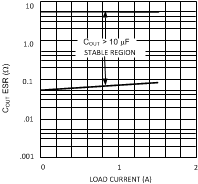 Figure 8. ESR Curve
Figure 8. ESR Curve
8.2.2.2 CFF (Feed Forward Capacitor)
The capacitor CFF is required to add phase lead and help improve loop compensation. The correct amount of capacitance depends on the value selected for R1 (see Figure 7). Select a capacitor such that the zero frequency as given by the equation shown below is approximately 45 kHz:
Use a good-quality ceramic with X5R or X7R dielectric for the CFF capacitor.
8.2.2.3 Selecting a Capacitor
Capacitance tolerance and variation with temperature must be considered when selecting a capacitor so that the minimum required amount of capacitance is provided over the full operating temperature range. In general, a good tantalum capacitor shows very little capacitance variation with temperature, but a ceramic capacitor may not be as good (depending on dielectric type). Aluminum electrolytics also typically have large temperature variation of capacitance value.
Equally important to consider is how the ESR of a capacitor changes with temperature: this is not an issue with ceramics, as their ESR is extremely low. However, it is very important in tantalum and aluminum electrolytic capacitors. Both show increasing ESR at colder temperatures, but the increase in aluminum electrolytic capacitors is so severe they may not be feasible for some applications (see Capacitor Characteristics).
8.2.2.4 Capacitor Characteristics
8.2.2.4.1 Ceramic
For values of capacitance in the 10-µF to 100-µF range, ceramics are usually larger and more costly than tantalum capacitors but give superior AC performance for bypassing high frequency noise because of very low ESR (typically less than 10 mΩ). However, some dielectric types do not have good capacitance characteristics as a function of voltage and temperature.
Z5U and Y5V dielectric ceramics have capacitance that drops severely with applied voltage. A typical Z5U or Y5V capacitor can lose 60% of its rated capacitance with half of the rated voltage applied to it. The Z5U and Y5V also exhibit a severe temperature effect, losing more than 50% of nominal capacitance at high and low limits of the temperature range.
If ceramic capacitors are used, TI recommends X7R and X5R dielectric ceramic capacitors as they typically maintain a capacitance range within ±20% of nominal over full operating ratings of temperature and voltage. Of course, they are typically larger and more costly than Z5U/Y5U types for a given voltage and capacitance.
8.2.2.4.2 Tantalum
TI recommends using solid tantalum capacitors on the output because their typical ESR is very close to the ideal value required for loop compensation. They also work well as input capacitors if selected to meet the ESR requirements previously listed.
Tantalums also have good temperature stability: a good-quality tantalum typically shows a capacitance value that varies less than 10-15% across the full temperature range of −40°C to +125°C. ESR varies only about 2× going from the high to low temperature limits.
The increasing ESR at lower temperatures can cause oscillations when marginal quality capacitors are used (if the ESR of the capacitor is near the upper limit of the stability range at room temperature).
8.2.2.4.3 Aluminum
Aluminium capacitors offer the most capacitance for the money. The disadvantages are that they are larger in physical size, not widely available in surface mount, and have poor AC performance (especially at higher frequencies) due to higher ESR and equivalent series inductance (ESL).
Compared by size, the ESR of an aluminum electrolytic is higher than either tantalum or ceramic, and it also varies greatly with temperature. A typical aluminum electrolytic can exhibit an ESR increase of as much as 50× when going from 25°C down to −40°C.
Also note that many aluminum electrolytics only specify impedance at a frequency of 120 Hz, which indicates they have poor high-frequency performance. Use only aluminum electrolytics that have an impedance specified at a higher frequency (from 20 kHz to 100 kHz) for the LP3875-ADJ. Derating must be applied to the manufacturer's ESR specification, because it is typically only valid at room temperature.
Any applications using aluminum electrolytics must be thoroughly tested at the lowest ambient operating temperature where ESR is maximum.
8.2.2.5 Setting The Output Voltage
The output voltage is set using the resistors R1 and R2 (see Figure 7). The output is also dependent on the reference voltage (typically 1.216 V) which is measured at the ADJ pin. The output voltage is given by the equation:
This equation does not include errors due to the bias current flowing in the ADJ pin which is typically about 10 nA. This error term is negligible for most applications. If R1 is > 100kΩ , a small error may be introduced by the ADJ bias current.
The tolerance of the external resistors used contributes a significant error to the output voltage accuracy, with 1% resistors typically adding a total error of approximately 1.4% to the output voltage (this error is in addition to the tolerance of the reference voltage at VADJ).
8.2.2.6 Turnon Characteristics for Output Voltages Programmed to 2 V or Less
As VIN increases during start-up, the regulator output will track the input until VIN reaches the minimum operating voltage (typically about 2.2 V). For output voltages programmed to 2 V or less, the regulator output may momentarily exceed its programmed output voltage during start-up. Outputs programmed to voltages above 2 V are not affected by this behavior.
8.2.2.7 RFI/EMI Susceptibility
Radio frequency interference (RFI) and electromagnetic interference (EMI) can degrade the performance of any device because of the small dimensions of the geometries inside the device. In applications where circuit sources are present which generate signals with significant high frequency energy content (> 1 MHz), care must be taken to ensure that this does not affect the device regulator.
If RFI/EMI noise is present on the input side of the regulator (such as applications where the input source comes from the output of a switching regulator), good ceramic bypass capacitors must be used at the input pin of the device.
If a load is connected to the device output which switches at high speed (such as a clock), the high-frequency current pulses required by the load must be supplied by the capacitors on the device output. Because the bandwidth of the regulator loop is less than 100 kHz, the control circuitry cannot respond to load changes above that frequency. This means the effective output impedance of the device at frequencies above 100 kHz is determined only by the output capacitors.
In applications where the load is switching at high speed, the output of the device may need RF isolation from the load. TI recommends that some inductance be placed between the output capacitor and the load, and good RF bypass capacitors be placed directly across the load.
PCB layout is also critical in high noise environments, because RFI/EMI is easily radiated directly into PC traces. Noisy circuitry should be isolated from clean circuits where possible, and grounded through a separate path. At MHz frequencies, ground planes begin to look inductive and RFI/EMI can cause ground bounce across the ground plane.
In multilayer PCB applications, care must be taken in layout so that noisy power and ground planes do not radiate directly into adjacent layers which carry analog power and ground.
8.2.2.8 Output Noise
Noise is specified in two ways:
- Spot Noise (or Output Noise Density): the RMS sum of all noise sources, measured at the regulator output, at a specific frequency (measured with a 1-Hz bandwidth). This type of noise is usually plotted on a curve as a function of frequency.
- Total Output Noise (or Broad-Band Noise): the RMS sum of spot noise over a specified bandwidth, usually several decades of frequencies.
Attention must be paid to the units of measurement. Spot noise is measured in units µV/√Hz or nV/√Hz and total output noise is measured in µV(RMS).
The primary source of noise in low-dropout regulators is the internal reference. In CMOS regulators, noise has a low frequency component and a high frequency component, which depend strongly on the silicon area and quiescent current. Noise can be reduced in two ways: by increasing the transistor area or by increasing the current drawn by the internal reference. Increasing the area decreases the chance of fitting the die into a smaller package. Increasing the current drawn by the internal reference increases the total supply current (GND pin current). Using an optimized trade-off of the GND pin current and die size, the LP3875-ADJ achieves low noise performance and low quiescent-current operation.
The total output noise specification for LP3875-ADJ is presented in the Electrical Characteristics. The output noise density at different frequencies is represented by a curve under Typical Characteristics.
8.2.2.9 Power Dissipation
Knowing the device power dissipation and proper sizing of the thermal plane connected to the tab or pad is critical to ensuring reliable operation. Device power dissipation depends on input voltage, output voltage, and load conditions and can be calculated with Equation 3.
Power dissipation can be minimized, and greater efficiency can be achieved, by using the lowest available voltage drop option that would still be greater than the dropout voltage (VDO). However, keep in mind that higher voltage drops result in better dynamic (that is, PSRR and transient) performance.
On the TO-263 (KTT) package, the primary conduction path for heat is through the thermal tab into the PCB. In this package, the die is connected directly to the thermal pad and the heat generated in the die (junction) has a direct path through the large thermal tab into the PCB copper area.
In the SOT-223 (NDC) package, the primary conduction path for heat is through the GND Tab (pin 5) into the PCB. While the die (junction) is connected directly to the GND tab metal, this thermal path is longer and has a higher thermal resistance value than the TO-263.
To ensure the best thermal performance, place as large of a copper area directly under the thermal tab as is possible, and connect the thermal tab, through multiple thermal vias, to an internal ground plane with an appropriate amount of copper PCB area.
Power dissipation and junction temperature are most often related by the junction-to-ambient thermal resistance (RθJA) of the combined PCB and device package and the temperature of the ambient air (TA), according to Equation 4 or Equation 5:
Unfortunately, this RθJA is highly dependent on the heat-spreading capability of the particular PCB design, and therefore varies according to the total copper area, copper weight, and location of the planes. The RθJA recorded in Thermal Information is determined by the specific EIA/JEDEC JESD51-7 standard for PCB and copper-spreading area, and is to be used only as a relative measure of package thermal performance. For a well-designed thermal layout layout for the TO-263 (KTT) , RθJA is actually the sum of the package junction-to-case (bottom) thermal resistance (RθJCbot) plus the thermal resistance contribution by the PCB copper area acting as a heat sink.
8.2.2.10 Estimating Junction Temperature
The EIA/JEDEC standard recommends the use of psi (Ψ) thermal characteristics to estimate the junction temperatures of surface mount devices on a typical PCB board application. These characteristics are not true thermal resistance values, but rather package specific thermal characteristics that offer practical and relative means of estimating junction temperatures. These psi metrics are determined to be significantly independent of copper-spreading area. The key thermal characteristics (ΨJT and ΨJB) are given in Thermal Information and are used in accordance with Equation 6 or Equation 7.
where
- PD(MAX) is explained in Equation 5
- TTOP is the temperature measured at the center-top of the device package.
where
- PD(MAX) is explained in Equation 5.
- TBOARD is the PCB surface temperature measured 1-mm from the device package and centered on the package edge.
For more information about the thermal characteristics ΨJT and ΨJB, see Semiconductor and IC Package Thermal Metrics; for more information about measuring TTOP and TBOARD, see Using New Thermal Metrics; and for more information about the EIA/JEDEC JESD51 PCB used for validating RθJA, see the Thermal Characteristics of Linear and Logic Packages Using JEDEC PCB Designs. These application notes are available at www.ti.com.
8.2.3 Application Curves
Unless otherwise specified: TJ = 25°C, COUT = 10 µF, CIN = 10 µF, SD pin is tied to VIN, VOUT = 2.5 V, VIN = VO(NOM) + 1 V,IL = 10 mA
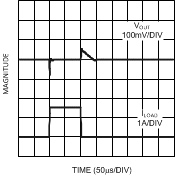
| CIN = COUT = 10 µF, Oscon | ||
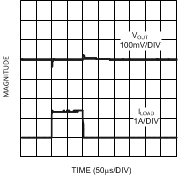
| CIN = COUT = 100 µF, POSCAP | ||
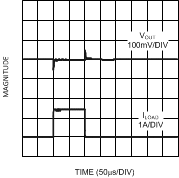
| CIN = COUT = 100 µF, Tantalum | ||
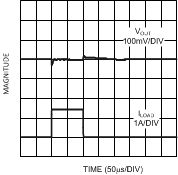
| CIN = COUT = 100 µF, Oscon | ||
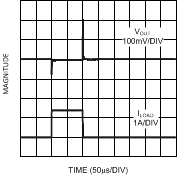
| CIN = COUT = 10 µF, Tantalum | ||